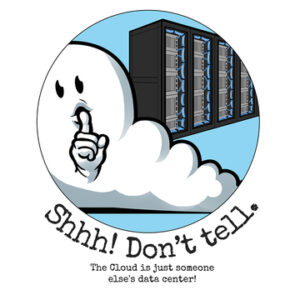
Confrontational marketing is a streetfighting mindset, used for tech startups, to harness hidden market dynamics and get a tech product to market fast with minimal or zero equity dilution.
Hidden market dynamics?
Well, yes.
Prospects, the ones you need to sell, absolutely loathe current marketing practices.
They know when they download a “white paper,” which is vendor propaganda, they get a phone call from that chirpy “business dev rep” called a BDR before reading the first paragraph.
Prospects understand if they give out their company email, they will be deluged with SPAM from “account based marketing” machines.
Confrontational marketing replaces these loathsome practices with CLARITY.
Clarity of message displays a competitive alternative to the status quo in stark contrast to major competitive options. Clarity enables the prospect to see how the new technology is different in kind from incumbents.
Let’s take an example.

Ok, that’s it!
We sent this cartoon to the senior tech management of Fortune 1,000 firms and posted it where the techies live and they hated it. We got hate mail. We were banned from one of the major social media sites for weeks!
That’s when we knew we were over the target!
We sent the cartoon to line-of-business types and we had a different reaction. They unanimously agreed there was zero transformation from “cloud migration.” They volunteered IT costs, moving to uncontrollable OPEX, were out of control. They just did not know there was an alternative.
We introduced System Oriented Programming, an alternative that reduced cloud bills by 90% or more, much more with apps running 1,000 times to a million times faster. Executives listened because their minds were opened up by clarity of message.
Confrontational marketing is not for everyone. Traditional technology marketing people will never use it; that’s why it is so powerful.
Confrontational marketing fundamentally understands: “Who wins a fight between a bear and an alligator? Depends on the terrain.”
Confrontational marketing is about understanding and managing the terrain of the early adopter, innovator and the person mandating change. It understands you can use the market positioning of industry leaders to position them, quickly, as dinosaurs. It understands most tech marketing is low risk white papers, branding, spam generation and other activities yielding diminishing returns.
Traditional marketing is all the same. So confrontational marketing makes you very different fast. And if you are telling the truth, which you better be, it has no antidote.
In the most fundamental sense, confrontational marketing is about uncovering the truth fast, and uncovering it for those to whom it matters.
Sure, you can go to market, do ads, go to forums, put your info on boards, hire a sales force and a spam generating marketing department and present at conferences. You can wait a lifetime before getting traction. You will spend millions of dollars, from VCs, and your equity will be diluted to lunch money.
Or you can realize your “terrain” is not the late adopter market. You want the innovator—the early adopter, the change demander.
You want the line-of-business executive who needs to make things happen now, not in 36 months.
You are attacking the left side of the traditional diffusion curve. Your terrain has vastly different dynamics.
Early adopters, P&L executives are looking for you. They understand if they can get an app out in 90 days that would take 36 months with traditional technology, they win big.
Marketing to the left of the diffusion curve, the innovator and early adopter is fundamentally different from everything one sees in tech marketing today. Screw branding; you are there to get truth to those who need it the fastest way possible.
You are bringing value; something not available anywhere else at any price.
When you have a technology that changes all the rules for the customer’s benefit, you encounter an analyst community, a traditional tech community, Dev/Ops types within major prospects for whom you will upend their world. They have zero interest in disruption. They want nothing to interfere with the Tuesday and Thursday evening kids’ soccer practice.
They are not there to uncover truth—that their company can gain spectacular results from a new way of programming and by eliminating the legacy products paying their salaries.
They are in the no risk, leave me alone, “don’t confuse me with the facts, my mind is made up,” mentality.
While employed by the customer, IT bureaucrats work for themselves—for what makes their life easy, pain-free, secure in the bosom of the safe, large company bureaucracy, protected by buzzwords that obscure the simplicity of what they do.
At first, this appears an impossible set of obstacles.
It is not. It is the terrain and it is your most powerful weapon—because you can be agile: they will always react with traditional organizational responses—and that is how you navigate around them to the benefit of the customer who needs that revolutionary app dev, but is shielded from its benefits by an IT bureaucracy.
Homer taught us a story is the most straightforward way to communicate. Here’s our story.
We were at a software company introducing the first almost-relational database. This was before Oracle brought relational to market. The database industry was divided between those using IBM databases and those who wrote their own. Most firms did not know what a database was.
Then a marketing powerhouse called Cullinet was born. It had a luminary CEO who built a marketing machine that captured the industry mindset. Cullinet was the darling of Wall Street and its stock was a story unto itself.
Every major company was buying or evaluating Cullinet; their growth was phenomenal. Their product appeared to be the best anyone could ever hope for and the customers apparently loved it. The CEO was on the cover of Business Week. They went public, they were unstoppable.
Our company was a geeky, high tech software firm and we were hired to sell an almost-relational database. We were kids in our 20s. We had to go against Cullinet.
Every competitive deal was a blowout for Cullinet. Who wouldn’t go with a company with a perfect product, that worked all the time and made every user a hero?
The terrain was defined by Cullinet.
Cullinet owned the analyst community. There were 4-5 Wall Street analysts who wrote glowing reports about them every quarter. Their sales reps handed out these reports to prospects thus insuring those companies would never buy from anyone else.
Well, that was their terrain. Changing the terrain is where our advantage lay—we just did not see it.
Several of us, young sales people at the time, had to find a way to change this terrain or just quit. We were streetfighters so the choice was made for us.
Our company had the traditional, corporate, brain-dead marketing department who built presentations, gave out coffee mugs and avoided risk. They even made us do a presentation that lasted 7 hours – with those 33mm slides. No kidding!
So it was up to us.
We, field sales reps, then went into “great Cullinet accounts” and interviewed people who loved the product but……
We met with former Cullinet employees who said the product was great, but….
The “but” was that it took so many people to make the product work due to some massively complex architecture (embedded pointer network for those geeks who care), that it was vastly expensive to maintain, it cost a ton to hire people to make it work and if you made a change in your business, you were pretty much screwed because it would take forever to adapt Cullinet to the business.
That was a start.
We now changed the terrain—let’s force every evaluation to how hard Cullinet is to CHANGE–and how expensive it is to ADAPT.
So we started forcing competitive benchmarks, where we had the customer change something and try to do it in our almost relational system and Cullinet. After one benchmark, where we crushed them (they could not finish it) they refused to ever do another one (this, boys and girls, is traditional marketing organizational response and you will see it every time).
Then we had prospects interview Cullinet “best customers.” We did not wait for the Cullinet rep to give out his or her reference list, we did if for them.
We gave the prospect the questions to ask—and they started with the “but.”
We encouraged each Cullinet customer to comment: “Cullinet is great if your business never changes, but ours does and we struggle to make Cullinet change with it.” Damned with faint praise maybe? Kind of a scary endorsement.
We positioned Cullinet as the best product for the business that never changes. And we had their customers saying it. Nice.
We took millions of dollars of Cullinet marketing effort by the best tech marketing group at the time, and with one sentence, we turned it against them.
Our traditional marketing department would NEVER have done something like this—traditional marketing does not think this way. It’s a brain-dead thing.
Nobody’s business does not change. Nobody’s. And we had Cullinet’s customers positioning them in a deadly corner.
When prospects learned the true hidden costs of Cullinet, they started buying our almost-relational product. One deal, then 3 or 4 then we were beating them most of the time.
Now for the fun stuff.
We met one of the industry analysts writing favorable Cullinet reports. We took him to dinner in Manhattan and said he might want the scoop on how Cullinet was just a house of cards and they were getting killed in the database market.
We introduced him to customers who bought us over Cullinet. We took him into some of our accounts where they did deep product comparisons.
And he saw the light, big time. Then the analyst reports started coming out noting Cullinet had missed the major technology trend—relational database and it might be in real trouble.
After a couple of these reports, the stock tanked big time. And with it, sales continued to slide. And turnover hit and the bad press grew.
We learned if you scare a company’s investors, they will bring a company to its knees fast.
No amount of traditional marketing could stop the collapse. Cullinet doubled down on traditional marketing. And it just did not work anymore.
In less than 30 months, they sold the company to CA for scrap.
Our sales soared and we had the chance to bring a relational database to market—but we chose not to because our product managers got in the way. Another blog post on that–why the product manager is the single greatest obstacle to greatness in a tech company.
But we – a few hardy, 20-something sales reps – discovered confrontational marketing.
Got the truth to customers fast, and made a lot of money and had a lot of fun doing it.
Once we changed the terrain, the outcome became deadly for our competitor. The alligator pulled the bear into the water or the bear pulled the alligator onto the shore. The terrain always determines the outcome.
And for a couple of 20-somethings, we learned a street fighting sales rep can topple an industry leader—-even with no help from marketing.
And today?
We brought the first similarity engine to market and sold it to eBay to stop auction fraud in its tracks. We launched System Oriented Programming , enabling companies to reduce IT costs over 50%, cut data center energy usage as much and lower cloud costs 90% or more. We are just getting started.
Are we selling to the CIO? Nope.
Too many of them are invested in the status quo. They have way too much to unlearn.
We are selling to the line-of-business exec who gets fired if she does not transform the business. We sell to the person who wants to see IT costs reduced 50% and experience results in a quarter.
Confrontational marketing.
How to take the market away from the timid—and the bureaucracies where they live.
